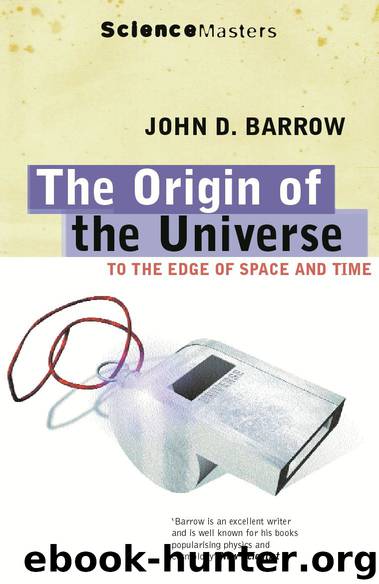The Origin of the Universe by John D. Barrow

Author:John D. Barrow [Barrow, John D.]
Language: eng
Format: epub
Tags: Science, Physics, Astrophysics, Nature, Sky Observation
ISBN: 9781780227610
Google: KHPhAgAAQBAJ
Amazon: B00IJGHN7K
Publisher: Hachette UK
Published: 2014-03-19T16:00:00+00:00
CHAPTER 5
INFLATION AND THE COBE SEARCH
It is quite a three-pipe problem, and I beg that you won’t speak to me for fifty minutes.
—The Red-headed League
In the spring of 1992, the news media of the world became excited by the announcement that NASA’s Cosmic Background Explorer (COBE) satellite had observed tiny variations in the temperature of the microwave background radiation around the sky. By observing the radiation from above the Earth’s atmosphere, the COBE satellite avoided spurious variations created by atmospheric changes and achieved greater accuracy than any similar Earth-based experiment. What it did was continually to switch its detector back and forth across the sky, over angles greater than about ten degrees (for comparison, the face of the full moon corresponds to about half a degree on the sky), and determine the difference in the temperature of the microwave background radiation photons coming toward us from those directions. What do the tiny temperature variations mean, and why did everyone get so excited about them (some extravagant commentators going so far as to claim the COBE data as the most important scientific discovery of all time!)?
We can understand the existence of structures like stars and planets by using our knowledge of basic physical principles. But when it comes to galaxies, our understanding is much more uncertain. We do not know whether a similar strategy of identifying balances between different forces of nature will suffice to explain why galaxies and clusters of galaxies have their observed masses and shapes and sizes. Almost certainly it will not. Galaxies and galaxy clusters are islands of material where the density of matter is enormously greater than the average density in the outside universe. The average density of the Milky Way galaxy, for example, is about a million times greater than that of the universe. That such irregularities exist is not mysterious. If we take a perfectly smooth distribution of matter and introduce a tiny nonuniformity, it will snowball, growing more and more pronounced. For there will be a greater gravitational pull toward any place where there is a slight overabundance of matter, and yet more matter will be drawn into it at the expense of the sparser regions beyond, and so the buildup proceeds.
This process is called “gravitational instability,” and it was first recognized by Isaac Newton three hundred years ago. Gravitational instability operates whether or not the universe is expanding—although aggregates of matter take longer to build up in an expanding universe, because the expansion tends to pull the aggregating material apart. But as the universe ages, the aggregates should become so dense compared with the rest of the universe that they cease to expand with the universal expansion (see figure 5.1). Instead, they become stable islands of matter, held in a balance between the inpull of gravity created by their constituents and the outward pressure exerted by the motions of their constituents. However, one can see that if we want to explain the origin of galaxies and galaxy clusters by the process of
Download
This site does not store any files on its server. We only index and link to content provided by other sites. Please contact the content providers to delete copyright contents if any and email us, we'll remove relevant links or contents immediately.
Tools of Titans by Timothy Ferriss(8303)
Turbulence by E. J. Noyes(7977)
Secrets of Antigravity Propulsion: Tesla, UFOs, and Classified Aerospace Technology by Ph.D. Paul A. Laviolette(5330)
Astrophysics for People in a Hurry by Neil DeGrasse Tyson(5149)
Room 212 by Kate Stewart(5067)
Design of Trajectory Optimization Approach for Space Maneuver Vehicle Skip Entry Problems by Runqi Chai & Al Savvaris & Antonios Tsourdos & Senchun Chai(5036)
Pale Blue Dot by Carl Sagan(4949)
The David Icke Guide to the Global Conspiracy (and how to end it) by David Icke(4653)
A Journey Through Divination and Astronomy by Publishing Pottermore(4363)
Goodbye Paradise(3760)
Apollo 8 by Jeffrey Kluger(3664)
COSMOS by Carl Sagan(3584)
Losing the Nobel Prize by Brian Keating(3518)
The Five People You Meet in Heaven by Mitch Albom(3515)
How to Read Water: Clues and Patterns from Puddles to the Sea (Natural Navigation) by Tristan Gooley(3430)
Brief Answers to the Big Questions by Stephen Hawking(3392)
How to Read Nature by Tristan Gooley(3289)
The Order of Time by Carlo Rovelli(3162)
A Brief History of Time by Stephen Hawking(2990)
